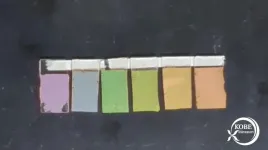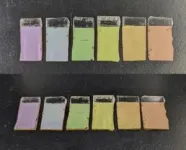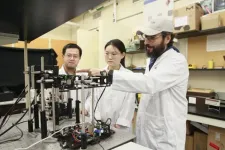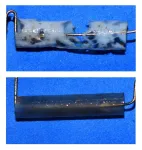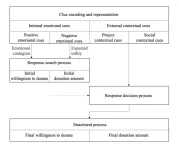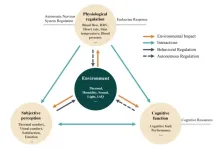(Press-News.org) A new way of creating color uses the scattering of light of specific wavelengths around tiny, almost perfectly round silicon crystals. This Kobe University development enables non-fading structural colors that do not depend on the viewing angle and can be printed. The material has a low environmental and biological impact and can be applied extremely thinly, promising significant weight improvements over conventional paints.
An object has color when light of a specific wavelength is reflected. With traditional pigments, this happens by molecules absorbing other colors from white light, but over time this interaction makes the molecules degrade and the color fades. Structural colors, on the other hand, usually arise when light is reflected from parallel nanostructures set apart at just the right distance so that only light of certain wavelengths will survive while others are cancelled out, reflecting only the color we see. This phenomenon can be seen in wings of butterflies or feathers of peacocks, and has the advantage that the colors don't degrade. But from an industrial point of view, neatly arranged nanostructures cannot be painted or printed easily, and the color depends on the viewing angle, making the material iridescent.
Kobe University material engineers FUJII Minoru and SUGIMOTO Hiroshi have been developing an entirely new approach to producing colors. They explain, “In previous work since 2020, we were the first to achieve precise particle size control and develop colloidal suspensions of spherical and crystalline silicon nanoparticles. These single silicon nanoparticles scatter light in bright colors by the phenomenon of ‘Mie resonance,’ which allows us to develop structural color inks.” With Mie resonance, spherical particles of a size comparable to the wavelength of light reflect specific wavelengths particularly strongly. This means that the color that mainly comes back from the suspension can be controlled simply by varying the size of the particles.
In their work now published in the journal ACS Applied Nano Materials, Fujii and Sugimoto demonstrate that the suspension can be applied to surfaces and will thus coat the underlying material in a form of structural color that does not depend on the viewing angle. This is because the color is not produced by the interaction of light reflected from neighboring structures as with “traditional” structural colors, but by its highly efficient scattering around individual nanospheres. Sugimoto explains another advantage: “A single layer of sparsely distributed silicon nanoparticles with a thickness of only 100-200 nanometers shows bright colors but weighs less than half a gram per square meter. This makes our silicon nanospheres one of the lightest color coats in the world.”
The Kobe University team used computational simulations to explore the properties of the ink under different circumstances, such as by varying the size of the particles and the distance between them, and then confirmed their results experimentally. They found that, contrary to intuition, the reflectance was highest when the individual particles were separated instead of when tightly packed. The authors explain, “This high reflectance despite small coverage of the surface by the nanospheres is due to the very large scattering efficiency. The requirement of a very small amount of silicon crystals for coloration is an advantage in the application as a color pigment.”
After further development and refinements, they are expecting interesting applications of their technology. Sugimoto explains, “We can apply it to the coating of, for example, airplanes. The pigments and coatings on an airplane have a weight of several hundreds of kilograms. If we use our nanosphere-based ink, we might be able to reduce the weight to less than 10% of that.”
This work was partially supported by JSPS KAKENHI grants 18KK0141, 21H01748, 21H01782 and 22K18949, the JST FOREST Program grant JPMJFR213L and the JST START University Promotion Type grant JPMJST2051 (Kobe University GAP fund).
Kobe University is a national university with roots dating back to the Kobe Commercial School founded in 1902. It is now one of Japan's leading comprehensive research universities with nearly 16,000 students and nearly 1,700 faculty in 10 faculties and schools and 15 graduate schools. Combining the social and natural sciences to cultivate leaders with an interdisciplinary perspective, Kobe University creates knowledge and fosters innovation to address society’s challenges.
END
Structural color ink: Printable, non-iridescent and lightweight
2024-01-30
ELSE PRESS RELEASES FROM THIS DATE:
A faster, more efficient imaging system for nanoparticles
2024-01-30
Teams led by professors Jinyang Liang and Fiorenzo Vetrone from the Énergie Matériaux Télécommunications Research Centre at the Institut national de la recherche scientifique (INRS) have developed a new system for imaging nanoparticles. It consists of a high-precision, short-wave infrared imaging technique capable of capturing the photoluminescence lifetimes of rare-earth doped nanoparticles in the micro- to millisecond range.
This groundbreaking discovery, which was published in the journal Advanced Science, paves the way for promising applications, particularly in the biomedical and information security fields.
Rare-earth ...
Lifetime of ‘biodegradable’ straws in the ocean is 8-20 months, study finds
2024-01-30
Plastic drinking straws that get into marine ecosystems make beaches unsightly and pose problems for turtles and seabirds. So, people increasingly favor alternatives marketed as biodegradable or compostable. But do marine microorganisms break apart those straws? Researchers conducted experiments with seawater and report in ACS Sustainable Chemistry & Engineering that some commercial bioplastic or paper straws might disintegrate within eight to 20 months in coastal ocean systems and switching to ...
Tomato juice’s antimicrobial properties can kill salmonella
2024-01-30
Washington, D.C.—Tomato juice can kill Salmonella Typhi and other bacteria that can harm people's digestive and urinary tract health, according to research published this week in Microbiology Spectrum, a journal of the American Society for Microbiology. Salmonella Typhi is a deadly human-specific pathogen that causes typhoid fever.
“Our main goal in this study was to find out if tomato and tomato juice can kill enteric pathogens, including Salmonella Typhi, and if so, what qualities they ...
Joint efforts to ensure the sustainability of our one and only Earth
2024-01-30
The 37th International Geological Congress (IGC 2024) in August 2024, Busan, Korea, will highlight a growing concern amid urgent threats posed by accelerated climate and environmental changes. This will prompt collaborative efforts towards ensuring the sustainability of our planet.
Abnormally high temperatures across the globe during the past year were expected to make 2023 the hottest year in Earth's history. This realization underscores the concept of climate change, which was once confined to academic desks but has since permeated into our daily existence.
Geologists now assert that the rapid climate and environmental changes necessitate ...
KIMM develops technology for detecting injection of medication to prevent medical accidents related to analgesic drug infusion pump in hospitals
2024-01-30
Excessive administration of analgesic drugs frequently results in medical accidents. To prevent the occurrence of these accidents, a drug infusion pump featuring a technology for safely detecting medication administration has been developed for the first time in the world.
The research team led by Senior Researcher Dong-kyu Lee of the Korea Institute of Machinery and Materials (President Seog-hyun Ryu, hereinafter referred to as KIMM), an institute under the jurisdiction of the Ministry of Science and ICT, has succeeded in developing the technology for customized sensor modules capable of measuring the extremely low flow rate of analgesic drug infusion pumps as well as the existence ...
Machine sentience and you: what happens when machine learning goes too far
2024-01-30
There’s always some truth in fiction, and now is about the time to get a step ahead of sci-fi dystopias and determine what the risk in machine sentience can be for humans.
Although people have long pondered the future of intelligent machinery, such questions have become all the more pressing with the rise of artificial intelligence (AI) and machine learningT. These machines resemble human interactions: they can help problem solve, create content, and even carry on conversations. For fans ...
Drexel researchers propose AI-guided system for robotic inspection of buildings, roads and bridges
2024-01-30
Our built environment is aging and failing faster than we can maintain it. Recent building collapses and structural failures of roads and bridges are indicators of a problem that’s likely to get worse, according to experts, because it’s just not possible to inspect every crack, creak and crumble to parse dangerous signs of failure from normal wear and tear. In hopes of playing catch-up, researchers in Drexel University’s College of Engineering are trying to give robotic assistants the tools to help inspectors with the job.
Augmenting visual ...
Residents of rural ‘glades’ take a ‘leap of faith’ to combat dementia
2024-01-30
The prevalence of Alzheimer’s disease and related dementias (ADRD) is disproportionately high among rural, racially/ethnically diverse older residents. In fact, they face up to an 80 percent greater risk of cognitive impairment in older age, and 2.5 times potentially preventable ADRD-related hospitalizations compared to urban dwellers. It is estimated that early and accurate diagnosis in the mild cognitive impairment stage could save up to $7 trillion in patients’ health and long-term care costs by 2050.
To address these health disparities in rural underserved populations, researchers from Florida ...
Emotions drive donation behavior in disease relief projects on a fundraising platform
2024-01-30
The digital age has profoundly changed how we communicate as humans. Today, we can regularly interact with people we are unrelated to and unacquainted with in real time across the world. Because of this, individuals can now engage in prosocial behaviors, including cooperating, sympathizing, helping and donating, with complete strangers, but the motivating factors behind these behaviors are poorly understood. Analysis of data generated from a fundraising website suggests that positive emotions elicit higher total donation amounts while negative emotions result in higher individual donation amounts.
Fundraising ...
Comfort isn’t only a feeling, it’s a study
2024-01-30
A lot of factors go into an individual’s comfort, and it’s more than just how one feels about the temperature
The thermal environment refers to the physical surroundings as it pertains to the heat exchange of an individual and its environment. Naturally, the thermal environment also relates to comfort, or more specifically, thermal comfort. This type of comfort is an important metric to measure an individual’s feelings as it relates to their environment and can be directly associated with health, efficiency, comfort, and energy consumption. ...
